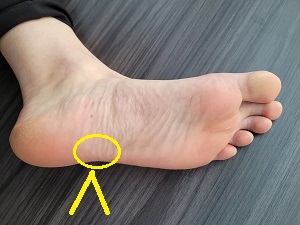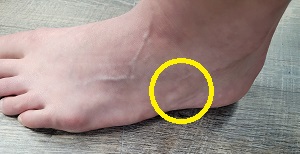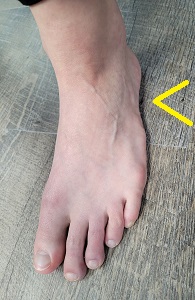
What is Cuboid Syndrome?
Cuboid syndrome occurs when the cuboid bone has shifted out of place. The cuboid bone is located on the outside of the foot, in the small dip after the heel bone. The bone may shift to the top, outside and bottom of the foot, because It does not connect to other bones there.
Causes of Cuboid Syndrome
The cause of cuboid syndrome can be from the mechanics of the feet, an injury or a combination of factors.
Mechanics
The mechanics of the feet can lead to cuboid syndrome through collapsed arches or even high arches.
 If the joints are very flexible through the middle of the foot, this can cause a mechanical instability. Typically, these flexible joints will lead to collapsed arches or overpronation (rolling in). When the arch collapses or pronates, the bones on the outside column unlocks for a longer time than it should. This causes the cuboid to move, and become more likely to shift out of place. Also, the muscles on the outside work harder to keep the column in place, which increases the force to these structures. The combination of the increased force and the instability to the outside column increases the likelihood of the cuboid shift.
If the joints are very flexible through the middle of the foot, this can cause a mechanical instability. Typically, these flexible joints will lead to collapsed arches or overpronation (rolling in). When the arch collapses or pronates, the bones on the outside column unlocks for a longer time than it should. This causes the cuboid to move, and become more likely to shift out of place. Also, the muscles on the outside work harder to keep the column in place, which increases the force to these structures. The combination of the increased force and the instability to the outside column increases the likelihood of the cuboid shift.
Cuboid syndrome can also occur with high arches, but it is not as common as a low arch. Though not completely clear, it may be due to increased shock through the foot as well as increased pressure to the outside of the foot.
Injury
Injuries can cause cuboid syndrome by causing instability or through the force of an injury.
Chronic/frequent inversion ankle sprains can injure the supporting structures and lead to instability to the cuboid. Inversion is the most common type of ankle sprain. It occurs when your roll your ankle inwards, or you roll onto the outside of your ankle. After many ankle sprains on the same foot, the structures on the outside of the ankle can become stretched out. These structures help to support the column on the outside of the foot, which contains the cuboid bone. With less stability here, the cuboid is more likely to shift out of place.
A single inversion ankle sprain can also cause cuboid syndrome. This can occur when the force of the ankle sprain and the pull to all the structures in the area, is enough to shift the cuboid out of place.
 What will I feel and see?
What will I feel and see?
Cuboid syndrome typically presents with pain at or around the cuboid bone. This could be on the top of the foot, just in front of the outside of the ankle, in the dip on the outside of the foot or directly under the outside of the foot. The area may be sore to touch, or there may be pain while walking, running or standing. Looking at the pain a little further, it may be worse when transferring your weight from the heel to the ball of the foot. In some cases, the pain may be present at night or while resting.
Visible signs may also be present through redness, swelling and possibly bruising in the area.
Pedorthic Treatments for Cuboid Syndrome
Orthotics and shoes help to address cuboid syndrome by providing support and preventing excessive motion. In addition to pedorthic treatments, other treatment strategies may be necessary to provide pain relief, such as a manual therapist.
Orthotics
Custom-made foot orthotics can be used to support the feet and prevent excessive motion that leads to instability. In the case of a collapsed arch/pronation, the orthotic device helps to stabilize the outside column while weight is pushing through there. With a high arch, and orthotic may help to address issues related to shock absorption or with excessive weight to the lateral column.
Shoes
The proper shoe can help to stabilize the cuboid and prevent excessive motion. There are a few features to look for with cuboid syndrome. A stable base, that does not bend easily through the middle, will prevent the foot from moving from side to side. A strong heel counter, that does not bend easily at the back, will prevent the heel from moving around. The appropriate amount of support on the shoe is also important. Be aware that the shoe should not overcorrect the foot by pushing it too far outwards. A shoe with a stability feature means there is additional support on the inside of the shoe. This may be appropriate for a collapsed arch, but may not be appropriate with an orthotic device or a high arch.
Other
Manual therapy may also be helpful in addressing alignment or balance issues. A practitioner such as a chiropractor or physiotherapist can help to address these issues.
If it sounds like the condition you have, or you would like more information, feel free to contact us or book an appointment!


You must be logged in to post a comment.